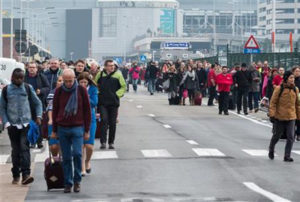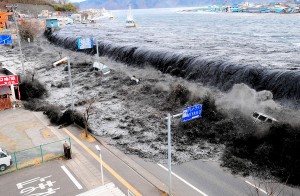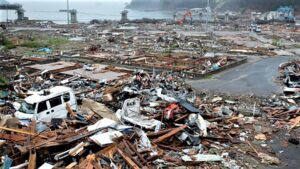
In all of my travels, I have experience of only two countries … Japan & Cuba … where there is a profound level of Social Resilience … the most important component of Urban Resilience. BUT, on the other hand … where poverty, discrimination, social exclusion, inequity, and injustice exist … there is always a high risk of Violent Social Disruption and Environmental Devastation …

.

WHEN, not if … Urban Resilience is fully elaborated and understood, it will have a profound impact on all tasks, activities and types of performance in the Human Environment (including the social, built, economic and virtual environments) … under all aspects of Sustainable Human and Social Development …

After working for many years on Climate Change, particularly Adaptation … it was quite natural for me to encounter the concept of …
RESILIENCE: The ability to function reliably during normal conditions, to withstand, adapt to or absorb unusual disturbance, disruption or damage, and thereafter to quickly return to an enhanced state of function.
See my Post, dated 2013-01-13 … https://www.cjwalsh.ie/2013/01/driving-harder-deeper-into-sustainable-development/
.
HOWEVER … this concept must now be expanded to also include Severe Natural Events (e.g. earthquakes, typhoons, tsunamis), Complex Humanitarian Emergencies, (e.g. mass human migrations, regional famines), Extreme Man-Made Events (e.g. 2001 WTC 9-11 Attack, 2008 Mumbai ‘Hive’ Attacks), and Hybrid Disasters (e.g. 2011 Fukushima Nuclear Incident).

AND … as URBANIZATION is proceeding at such a rapid pace in the BRICS Countries (Brazil, Russia, India, China & South Africa) and throughout the rest of the Southern Hemisphere … ‘practical’ and ‘easily assimilated’ trans-disciplinary output from collaborative international research is urgently required.

.
.
The CITY (as Region)
A geographical region, with open and flexible boundaries, consisting of:
(a) An interwoven, densely constructed core (built environment) ;
(b) A large resident population of more than 500,000 people (social environment) ;
(c) A supporting hinterland of lands, waters and other natural resources (cultivated landscape) ;
together functioning as …
(i) a complex living system (analogous to, yet different from, other living systems such as ecosystems and organisms) ; and
(ii) a synergetic community capable of providing a high level of individual welfare, and social wellbeing for all of its inhabitants.
SUSTAINABLE DESIGN
The creative and ethical design response, in resilient built and/or wrought form, to the concept of Sustainable Human & Social Development.
.
.
A. SUSTAINABLE CLIMATE CHANGE ADAPTATION
Adaptation to Climate Change is Urgent … Reliable Implementation is the Challenge … Integration into Sustainability Strategies and Policies is Essential.
Climate Change Adaptation Target: A Global Average Temperature Rise of 3.0 degrees Celsius, +/- 0.5 deg. C
Mitigation continues to fail. The future is unpredictable and surprises are likely. Non-linear and cascading impacts on the earth’s climate system, as well as impact synergies … must be considered in this target for climate resilience performance (social, environmental, economic, institutional, and political).

C.J. Walsh Technical Paper
2010 CIB World Building Congress in Manchester, England
‘Sustainable Climate Change Adaptation’
Click the Link Above to read and/or download PDF File (174 kb)
.
Irish National Report for Public Comment: 18 November 2010
IRELAND – Part II National Report for CIB Climate Change Project
Click the Link Above to read and/or download PDF File (787 kb)
.
CLIMATE-ADAPT – E.U. Climate Change Adaptation Web Portal
.
.
CIB Task Group 87: ‘Urban Resilience – Benchmarking & Metrics’
A Task Group of CIB (International Council for Research & Innovation in Building &  Construction) … CIB TG87 is an international, multi-stakeholder, trans-disciplinary forum for discussion, and action, on research and innovation in Urban Resilience Benchmarking & Performance Indicators intended for the spatial planning, design, engineering, construction and operation of a Safe, Resilient and Sustainable Human Environment (including the social, built, economic and virtual environments).
Construction) … CIB TG87 is an international, multi-stakeholder, trans-disciplinary forum for discussion, and action, on research and innovation in Urban Resilience Benchmarking & Performance Indicators intended for the spatial planning, design, engineering, construction and operation of a Safe, Resilient and Sustainable Human Environment (including the social, built, economic and virtual environments).
CIB TG 87’s Aims & Objectives …
1. To create an ongoing information-gathering, research and innovation focus for the development of a comprehensive, coherent, rational and empirical Metrics System which will be used to target and monitor the implementation of a Resilient and Sustainable Human Environment.
2. To promote the acceptance of Resilience Benchmarking & Performance Indicators worldwide, and to encourage their use in relevant policy and decision making, and relevant international/regional/national/local legislation, codes, regulations, standards and administrative provisions … by all sectors of society.
3. To provide Technical Input, from an urban resilience perspective, to other relevant CIB Working Commissions and Task Groups.
4. To facilitate a Transfer of State-of-the-Art Resilience Knowledge and to encourage Capacity Building for Resilience at international levels … particularly in the least developed countries and small island states.
5. To liaise and co-operate/collaborate with Other Organizations having similar or related aims and objectives.
To Meet CIB TG 87’s Aims & Objectives …
- Research and innovation projects with a specific task, well-defined scope and a limited timeframe may be initiated and directly/indirectly undertaken by the Membership of CIB TG87 ;
- Output from these projects and the other work of TG87 may be placed in the public domain, in hardcopy and/or electronic formats, as CIB publications, as papers/articles in international journals, conference/seminar/workshop proceedings, and discussion/reflection documents ;
- Conferences/seminars/workshops and other events which further TG87′s Aims & Objectives may be organized by the Membership of TG87 ;
- CIB may endorse conferences/seminars/workshops and other events planned by organizations having similar or related aims and objectives to TG87 ;
- TG87 may circulate its publications and information on its research and innovation projects to the membership of other CIB Working Commissions and Task Groups.
CIB TG 87 Membership:
Members of this Task Group have to be either a Representative of a CIB Member Organisation or an Individual CIB Member.
.
.
.
END
